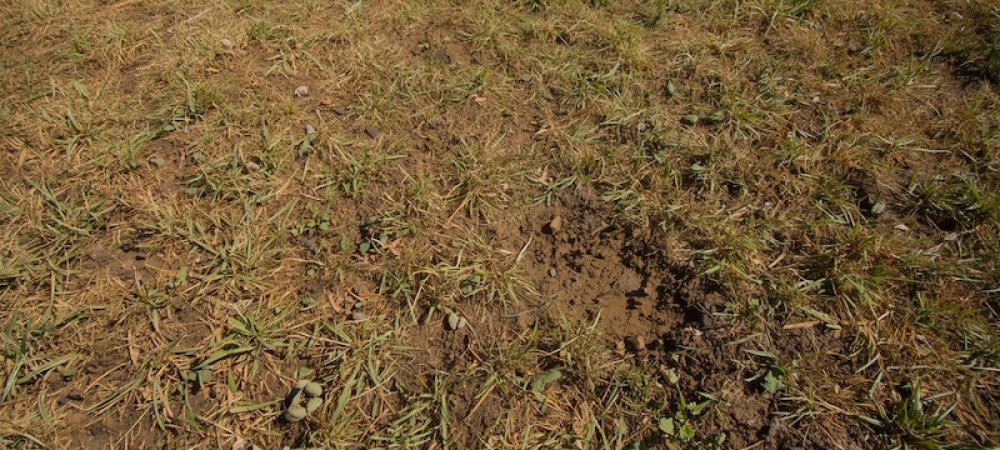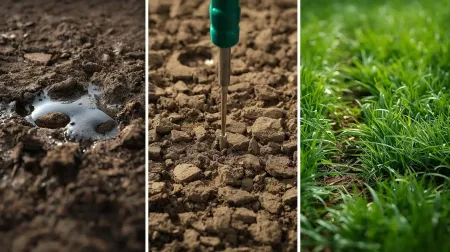
Aeration, Overseeding & Lawn Renovation: When Repair Outperforms Replacement
Homeowners in Michigan often face the question: is my lawn tired and in need of help, or is it past the point of repair? The decision often comes down to whether aeration and overseeding can bring your turf back to life, or if a full renovation is a smarter long-term investment. Aeration and overseeding can transform a thin, compacted lawn into one with new growth, while renovation is reserved for extreme cases where weeds and dead grass have overtaken most of the yard. Knowing when to choose repair over replacement can save money and ensure your lawn thrives for years to come.
Why Aeration Matters: Soil Compaction, Water, and Roots
Aeration is one of the most overlooked services in lawn care, but it delivers some of the biggest long-term benefits. By using a machine to pull plugs of soil from the ground, aeration reduces compaction and creates pathways for air, water, and nutrients to reach the root zone.
Over time, soil naturally becomes compacted from mowing, foot traffic, and environmental stress. When the soil is too dense, grass roots cannot grow deeply. Shallow roots make turf more prone to drought stress and invasive weeds. Aeration solves this problem by opening up the soil and providing roots with the space they need.

Signs your lawn may need aeration include:
- Water is pooling on the surface instead of soaking in.
- Soil that feels hard when probed with a screwdriver.
- Heavy-use areas, such as play zones or paths, where grass tends to thin easily.
When performed at the right time, usually in early fall, aeration becomes the foundation for overseeding and lawn recovery.
Best Timing: Why Fall is the Secret Weapon for Michigan Lawns
Timing is everything when it comes to lawn aeration and overseeding. In Michigan, lawns are typically composed of cool-season grasses, such as Kentucky bluegrass, perennial ryegrass, and fescues. These grasses thrive when daytime temperatures are mild, nights are cool, and soil moisture is consistent.
That is why late summer into early fall is considered the “sweet spot.” During this window, several important advantages line up:
- Reduced weed competition – Many annual weeds die off in the fall, giving new seedlings less competition.
- Cooler nights – Help prevent drought stress during germination.
- Consistent rainfall – Improves seed-to-soil contact and growth.
Spring aeration is possible, but it comes with challenges. Weeds like crabgrass are active in the spring, and the upcoming summer heat can strain new grass before it has a chance to mature. For most Michigan homeowners, fall aeration and overseeding will deliver the best return on investment.
Overseeding vs. Full Renovation — How to Decide
Overseeding is essentially repairing your existing lawn by adding new grass seed into thin or patchy areas. It works well when your soil is healthy, weeds are relatively under control, and at least half of your existing lawn is strong enough to support new growth.
A full renovation, on the other hand, is more like starting over. It may require killing existing weeds, grading problem areas, bringing in topsoil, or addressing drainage issues before reseeding or sodding. Renovation is typically reserved for situations where overseeding alone cannot achieve success.
General guidelines:
- If your lawn still has 50–70% desirable grass, overseeding is the best option.
- If your lawn is made up mostly of weeds, suffers from long-term neglect, or has uneven grading and bare spots, renovation is the smarter long-term path.
Sequencing Aeration, Overseeding, and Fertilization
One of the most common mistakes homeowners make is performing lawn care tasks in the wrong order. Sequencing services properly ensures seed germinates quickly and roots establish with minimal risk.
Here’s a proven approach for Michigan lawns:
- Dethatch if necessary – If your lawn has a spongy layer of thatch thicker than half an inch, remove it first so water and seed make full contact with the soil.
- Core aerate – Run an aerator over the lawn, leaving behind plugs of soil to open pathways.
- Overseed directly after aeration – Grass seed dropped during this step falls into the open holes, protecting it from wind and birds while ensuring strong seed-to-soil contact.
- Starter fertilizer – Apply a gentle, nutrient-rich starter fertilizer to support early root growth without overwhelming seedlings.
- Watering schedule – Water lightly and frequently for 2–3 weeks until germination, then transition to deeper, less frequent watering.
- Grub control – If needed, use a treatment, but avoid herbicides immediately after seeding since they can harm young grass.
When done properly, these steps work together to deliver a thicker, deeper-rooted lawn that recovers quickly in the following spring.
DIY or Professional Service — Which Delivers Better Results?
Lawn aeration and overseeding can technically be done as a DIY project, but the success rate between DIY and professional service tends to differ significantly. One major hurdle for the DIY route is the cost of equipment. Aerator rental machines from home improvement stores are often lighter and may struggle to penetrate heavily compacted soil. Coverage is another challenge since inconsistent passes can leave areas untreated.
Professionals use commercial-grade aerators that pull deeper cores, ensuring even coverage across the full lawn. Pairing aeration with professional overseeding also ensures high-quality seed matched to Michigan’s climate. While hiring a lawn company is an upfront investment, it often yields healthier, more uniform turf that saves homeowners from repeated attempts.
For homeowners who want to make sure they get the deepest plugs, the right seed blend, and proper fertilization, professional service is typically the best option.
Landscaping and Renovation Opportunities After Aeration
Aeration season creates opportunities beyond just turf thickness. Once the soil is opened and improved, it can be the perfect time to install complementary landscape projects. Consider upgrades such as:
- Adding flower beds or pollinator-friendly strips to boost curb appeal
- Refreshing hardscape elements like edging, patios, or walkways
- Installing or upgrading irrigation systems for better watering efficiency
By tackling these improvements in tandem, homeowners can maximize both the lawn’s health and the overall appeal of their property.
Maintaining a Lawn After Aeration and Overseeding
The weeks following aeration and overseeding are critical. A common mistake is assuming the job is finished once seeds are spread. Newly germinated grass is tender and requires specific care.
Best practices for the first 8–12 weeks include:
- Water lightly daily, keeping soil consistently moist for the first 2–3 weeks
- Avoid mowing until the grass reaches at least 3–4 inches in height
- Mow high (3 inches or more) and never remove more than one-third of the blade at a time
- Fertilize six to eight weeks after seeding to encourage root development
- Limit foot traffic to allow seedlings to establish
When followed with annual aeration and overseeding every two to three years, these steps help lawns remain dense and resilient against weeds, drought, and disease.
Professional Lawn Renovation in Michigan
A healthy lawn improves curb appeal, increases property value, and provides a safer outdoor space for families. For Michigan homeowners, aeration and overseeding are often enough to restore a stressed lawn. However, there are times when a full renovation is the smartest investment.
If you are unsure which approach is best for your property, consulting with a local lawn care specialist is the best first step. The experts at Dynamic Lawn & Landscape provide on-site assessments to determine whether aeration and overseeding will restore your turf or if a full renovation would deliver a better return.
